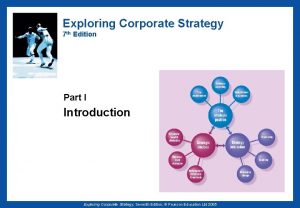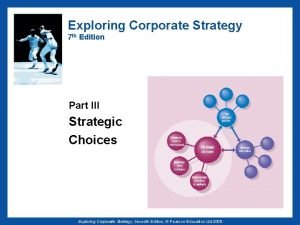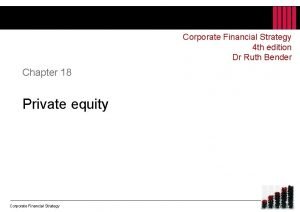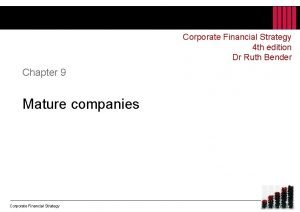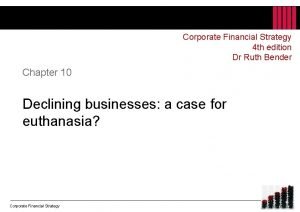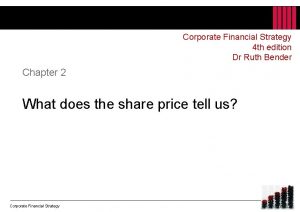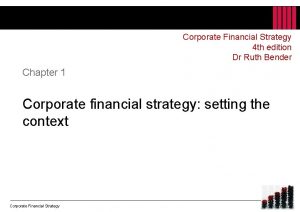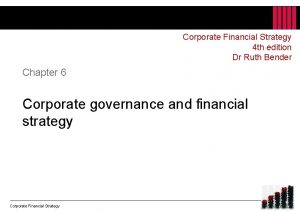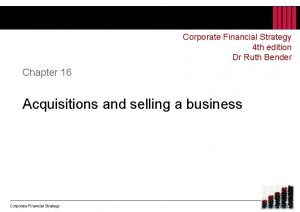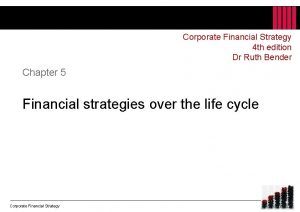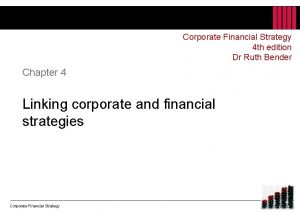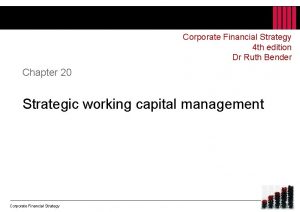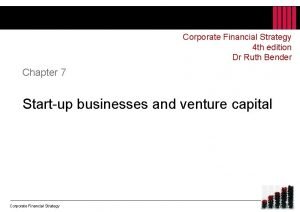Corporate Financial Strategy 4 th edition Dr Ruth












- Slides: 12

Corporate Financial Strategy 4 th edition Dr Ruth Bender Chapter 17 Restructuring a company Corporate Financial Strategy

Restructuring a company: contents § Learning objectives § Reasons for restructuring, and possible approaches § Some warning signs § Debt equity swap § Determining the shortfall for creditors § Stakeholders have choices § Tips for those planning a distressed acquisition § Spin-offs § Carve-outs § Some reasons why demergers can add value Corporate Financial Strategy 2

Learning objectives 1. Diagnose when a company is in trouble, and identify ways in which its cash flow can be improved to stave off a cash crisis. 2. Identify potential sources of finance for a troubled company, and evaluate how appropriate they are. 3. Understand some of the regulatory mechanisms underlying company rescue or liquidation. 4. Explain what spin-offs and carve-outs are, and how they differ. Corporate Financial Strategy 3

Reasons for a restructuring, and possible approaches Wrong financial strategy Wrong business strategy Too little debt Too much debt Pay a special dividend Improve operating efficiency Undertake a buyback Invest Change strategy Sell assets Raise new finance Restructure existing debt Corporate Financial Strategy 4

Some warning signs § The company is trading close to the limit on its bank facilities. § Monthly management accounts continually show negative variances on sales and profits. § There are no monthly management accounts, or they arrive late, with inadequate explanation. § Several key people leave the company in a short period of time. § Loss of several customers. § Poor relationships with suppliers. Corporate Financial Strategy 5

Debt –equity swap After Before Debt Equity held by previous Debt holders Equity Corporate Financial Strategy 6

Determining the shortfall for creditors Assets are insufficient to meet all claims Claims on the company Unsecured creditors Shortfall to creditors Shortfall on charged assets Amounts loaned under a floating charge (value restricted to the value of those charged assets) Realizable value of business / assets (whichever is greater) VALUE BREAK Amounts loaned under a fixed charge (value restricted to the value of those charged assets) Costs of restructuring (professional fees) Based on: ICAEW Corporate Finance Faculty, Best-practice Guideline – Turnarounds Corporate Financial Strategy 7

Stakeholders have choices § Creditors (unsecured) § Ordinary shares − Put in more money − Accept dilution − Write off part of the debt − Negotiate payment terms − Take equity § Debt − − Put in more money Swap to equity Write-offs Note that all the different lenders will have different views on what should happen § Employees − Trade-off between jobs and pay § Management − Fight to be part of the deal? Payoff? § Other stakeholders? ? Corporate Financial Strategy Page 8

Tips for those planning a distressed acquisition § Use advisers with previous experience of distressed acquisitions § Be prepared to undertake an accelerated due-diligence exercise, but on limited information § Clarify and resolve the legal position regarding charges on the company’s assets, and retention of title clauses § Determine which contracts with customers, suppliers, and landlords include an automatic termination clause in the event of insolvency, and resolve this § Ensure you have the funding in place so that you can move quickly § Incorporate the new business to ring-fence the assets and make sure that if things don’t work out it doesn’t threaten your existing business. When a management with a reputation for brilliance tackles a business with a reputation for poor fundamental economics, it is the reputation of the business that remains intact. Warren Buffett Corporate Financial Strategy 9

Spin-offs Owned by existing shareholders Company A Pre-transaction Corporate Financial Strategy Owned by existing shareholders Company A Post-transaction Company B spun off division of Company A 10

Carve-outs Owned by existing shareholders Company A Pre-transaction Owned by existing shareholders Owned by new shareholders and by Company A Company C spun off division of Company A Post-transaction Corporate Financial Strategy 11

Some reasons why demergers can add value § Separation into clearly defined business segments leads to market transparency and greater understanding. § Raise money by taking advantage of the market pricing one particular sector very highly. § The different businesses can follow financial strategies more appropriate to their activities. § Improvements in corporate governance and efficiencies arise in companies which were subsidiaries but are now separately accountable to the markets. § Incentive structures can be put in place that link management performance directly to the unit’s share price. § Removal of the ‘conglomerate discount’. Corporate Financial Strategy 12
 Exploring corporate strategy 7th edition
Exploring corporate strategy 7th edition Exploring corporate strategy 7th edition
Exploring corporate strategy 7th edition Exploring corporate strategy 7th edition
Exploring corporate strategy 7th edition Corporate financial strategy
Corporate financial strategy Business strategy vs corporate strategy
Business strategy vs corporate strategy Strategic management chapter 7
Strategic management chapter 7 Objectives of corporate governance
Objectives of corporate governance Fundamentals of corporate finance 3rd canadian edition
Fundamentals of corporate finance 3rd canadian edition Corporate finance tenth edition
Corporate finance tenth edition Fundamentals of corporate finance canadian edition
Fundamentals of corporate finance canadian edition Fundamentals of corporate finance fifth edition
Fundamentals of corporate finance fifth edition Fundamentals of corporate finance 6th edition
Fundamentals of corporate finance 6th edition Corporate finance tenth edition
Corporate finance tenth edition
